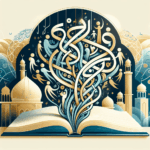The Intersection of the Arabic Alphabet and Modern Technology
In today’s fast-paced digital world, where technology evolves at lightning speed, the Arabic alphabet finds itself at an intriguing crossroads with modern technology. This intersection not only highlights the resilience and adaptability of the Arabic script but also underscores the important role it plays in connecting cultures and bridging communication gaps. Join me as we explore how the Arabic alphabet is making waves in the tech sphere! 🌍💻
Table of Contents
1. Introduction: The Timeless Arabic Alphabet
2. Modern Technology Meets Tradition
3. The Role of Arabic in Digital Communication
4. Arabic Language Processing and AI
5. Challenges and Innovations
6. Conclusion: The Road Ahead
7. FAQs
Introduction: The Timeless Arabic Alphabet
The Arabic alphabet, with its flowing script and rich history, is more than just a writing system; it’s a symbol of cultural identity for millions across the globe. Despite its ancient origins, this script is dynamically engaging with the digital age, proving that tradition and modernity can harmoniously coexist. 🌟
Modern Technology Meets Tradition
It’s fascinating to see how the traditional Arabic script integrates with contemporary technology. From software development to digital art, the Arabic alphabet is finding new life in various tech applications:
🖌️ Graphic Design: Artists and designers are using Arabic calligraphy in digital artworks, logos, and branding, creating visually captivating pieces that celebrate cultural heritage.
📱 Mobile Apps: With the rise of mobile technology, apps are increasingly incorporating Arabic language support, allowing more users to engage seamlessly in their native script.
The Role of Arabic in Digital Communication
In a world where communication is key, the Arabic language holds significant importance. Social media platforms, messaging apps, and websites are recognizing the need for Arabic-friendly interfaces:
🎯 Social Media: Platforms like Twitter, Facebook, and Instagram have made strides in supporting Arabic, enabling users to express themselves authentically and engage with a broader audience.
💬 Messaging Apps: WhatsApp, Telegram, and other messaging apps are enhancing their Arabic language capabilities, ensuring smooth communication for Arabic-speaking communities worldwide.
Arabic Language Processing and AI
The field of Artificial Intelligence (AI) and Natural Language Processing (NLP) is at the forefront of integrating Arabic into technology:
🤖 NLP: Researchers are developing sophisticated models to improve Arabic language processing, enabling better speech recognition, translation, and sentiment analysis.
🧠 AI Translation: Advanced AI tools are bridging linguistic gaps, making Arabic content more accessible to non-Arabic speakers and vice versa.
Challenges and Innovations
While the integration of Arabic into technology is promising, it comes with its own set of challenges:
🔍 Font Compatibility: Ensuring that Arabic scripts display correctly across different devices and platforms remains a hurdle, with ongoing efforts to standardize fonts and improve readability.
🛠️ Tech Support: Providing adequate technical support in Arabic is crucial for user satisfaction, necessitating a focus on developing bilingual customer service solutions.
Conclusion: The Road Ahead
The intersection of the Arabic alphabet and modern technology is a testament to the script’s adaptability and resilience. As technology continues to evolve, the Arabic script will undoubtedly find new ways to thrive in the digital landscape, enriching cultural exchanges and fostering global connectivity. 🚀
FAQs
Q1: How is the Arabic alphabet used in modern technology?
A1: The Arabic alphabet is used in graphic design, mobile apps, social media, messaging platforms, and more, enabling Arabic speakers to engage with technology in their native language.
Q2: What are the challenges of integrating the Arabic script into technology?
A2: Challenges include font compatibility across devices, developing robust NLP models, and providing effective technical support in Arabic.
Q3: How is AI enhancing the use of Arabic in technology?
A3: AI is improving Arabic language processing through advanced NLP models, enhancing translation accuracy, and making Arabic content more accessible globally.
Q4: Why is the integration of Arabic in digital platforms important?
A4: It ensures that Arabic speakers can communicate effectively, access information, and engage with technology in their native language, promoting inclusivity and cultural preservation.





